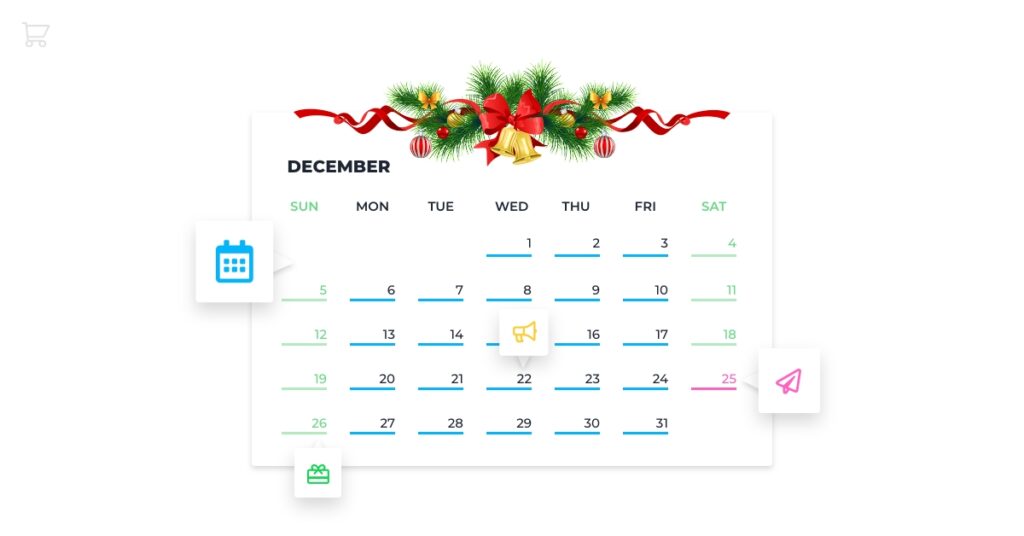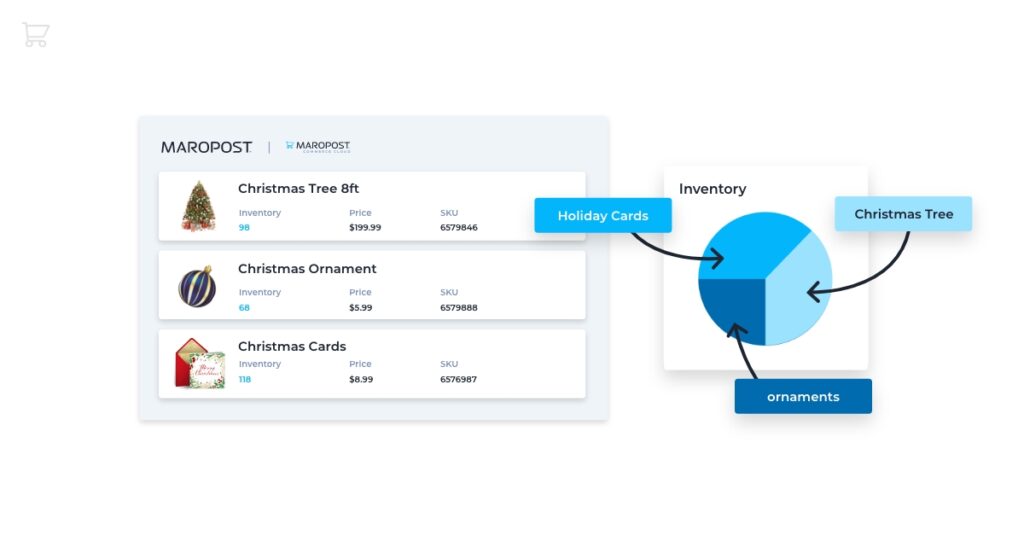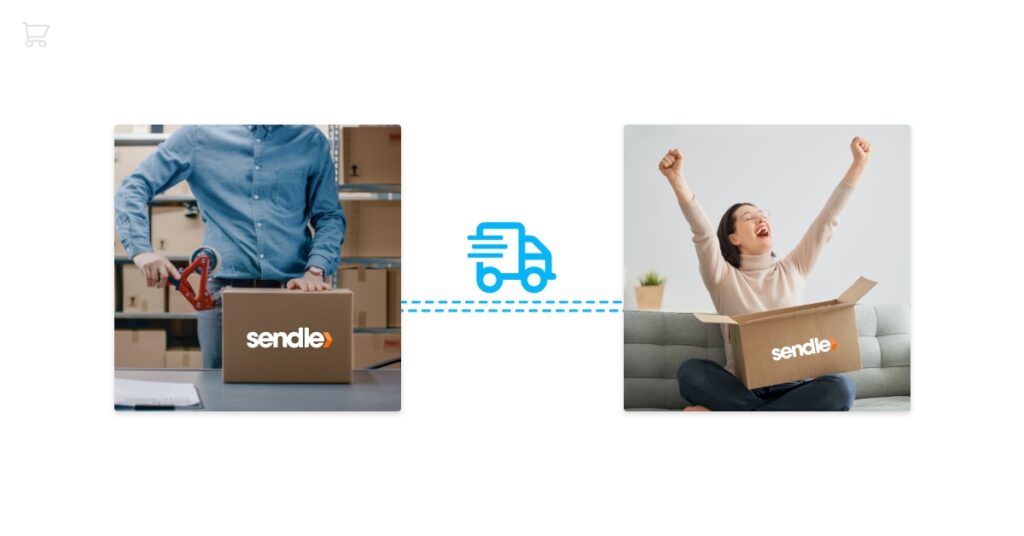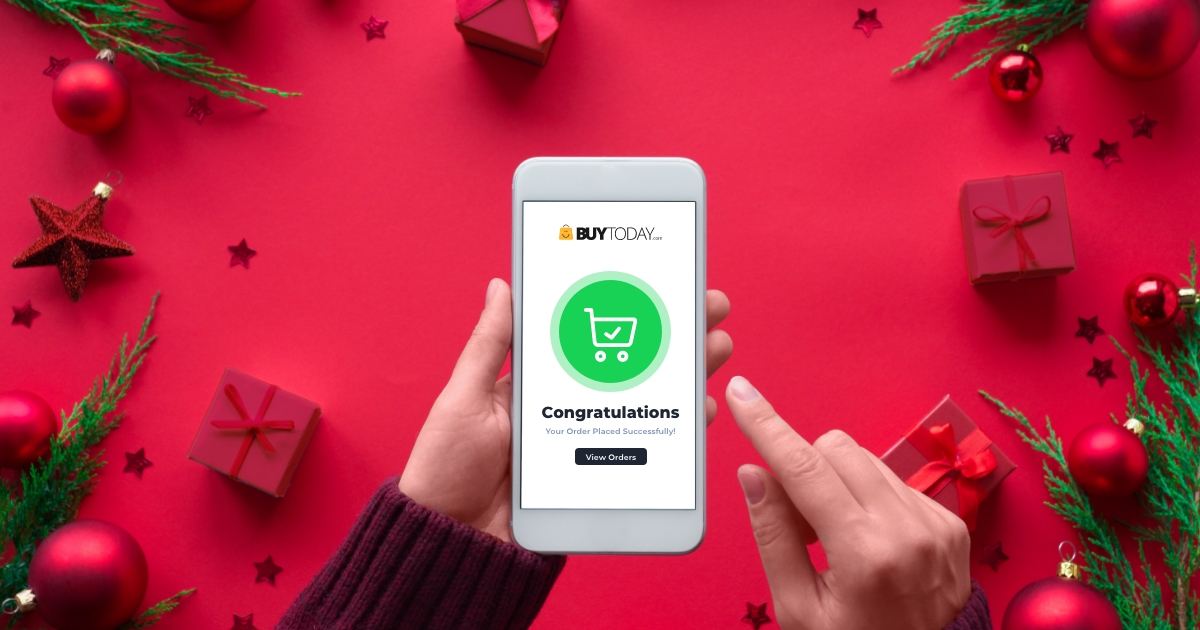Whether you’re a marketer or an ecommerce store owner (or maybe both), it’s likely that your holiday ecommerce sales are going to be significantly impacted by the success of your marketing efforts. Check out our list below for some helpful advice that will help you boost your holiday sales.
- Make a plan
- Prep your ecommerce site for holiday traffic
- Work out shipping and fulfillment
- Take care of your customers
- Market & Promote
- Build Loyalty Right Away
- Get more ecommerce sales during the holidays
1. Make a plan
Before you dive deep into your Black Friday and Cyber Monday sales, consider what else’s coming and could be overlooked by your competition. Depending on your industry, some of these days might be highly relevant to your holiday shoppers. Why not run an extra promotion to show your target demographic that you get them? For example, if you offer socks as one of your SKUs, don’t miss December 4 – National Sock Day! It may sound silly, but who’s serious on social media? Or, if you’re a small business owner, make it known, especially on November 27 – Small Business Saturday. Here’s a complete list of holidays until the end of the year.
- World Vegan Day – November 1
- Melbourne Cup – November 2 (Australia)
- Diwali, November 4 (India)
- Bonfire Night – November 5 (UK)
- Veterans Day – November 11 (US)
- Remembrance Day – November 11 (Canada, Australia and UK)
- Singles’ Day – November 11 (China)
- International Men’s Day – November 19
- Thanksgiving – November 25 (US)
- Black Friday – November 26
- Small Business Saturday – November 27
- Hanukkah – November 28-December 6
- Cyber Monday – November 29
- National Sock Day – December 4
- Green Monday – December 13
- Christmas Eve and Day – December 24–25
- Boxing Day – December 26
- Kwanzaa – December 26-January 1
- New Year’s Eve – December 31

The earlier you start planning and executing your marketing strategy, the more time you’ll have to test ideas and optimize before the holidays arrive. It also helps to give yourself enough time to learn from previous mistakes in order to create a better plan this year.
Quick tip: Make sure you have enough stock in case there is huge demand for certain products this year.
2. Prep your ecommerce site for holiday traffic
There are many things to consider during this holiday shopping season. Here are a few pointers to help you maximize your digital sales.
1. Get ready for heavy website traffic
Traffic was exceptionally heavy last year, catching even some industry giants off guard. Many websites crashed over Black Friday and Cyber Monday, including the electronics retailer Best Buy, the global marketplace Etsy, and the clothing retailer Zara.
To avoid this, try load testing your site beforehand. It will simulate heavy traffic and will show you how your website will perform. Also, ensure your website software is up to date, run server maintenance, back up everything and consider CDN – a content delivery framework. The latter spreads the load to various servers, preventing a possible crash.
2. Optimize for mobile
On average, Americans spend over 500 hours per year on their mobile devices. This provides ample opportunity to capture their attention and get them talking about your brand. Just in ecommerce, the average smartphone conversion rate is 64% higher compared to desktop.
That’s why you need to consider how mobile users will experience your website. Less and less people are browsing on their computers (31% of retail purchases are made through mobile in the US), so make sure that the experience is seamless everywhere.
3. Assess inventory
The last thing you want is to buy too much of product X and not enough of product Y. Too much inventory will add costs and you might need to heavily discount it in the future. Too little might upset your customers – no one wants to find that perfect item only to realize it’s out of stock just before the holidays.

You can’t possibly know what your customers will crave this year – you can only guess what online retail trends are going to be like this year. But here’s a trick – analyze your ecommerce sales from the past years to see what the trends were. This can give you a hint into what’s coming and indicate how many of which products you might need.
4. Don’t make drastic changes
Online shoppers like knowing what to expect, especially during the stressful and extremely busy holiday season. They avoid crowded malls, opt for the convenience of online shopping and crave consistency. So when they log onto your site, make sure the layout is familiar. If you want to make a big change, do it before October or postpone it until after the holidays.
Here’s more: if you release a new design, an app update, or a new website altogether, it may break at the worst possible time.
Check out some more things you want to avoid this holiday season.
5. Ensure your checkout is frictionless
In online sales customer surveys, 28% of them blame the inconvenient checkout process for leaving. Don’t let this happen to you! How? Start by going through the checkout process yourself. Do you see any potential problems? Flag and fix them before you jump into seasonal sales!
Contrary to a popular belief, asking for too much information at checkout isn’t the greatest strategy. Yes, you may get some insights from all of that info, but you also risk losing sales and decreasing conversion rates.
So don’t try to get all the info right away. It’s best to give your customers options – guest checkout or account creation. Give them reasons to create an account (maybe a special offer, a coupon, more customized product recommendations and more), but also provide an option to check out as a guest. When customers are in a pinch and need to buy holiday gifts quickly, they don’t have time to create an account. And they shouldn’t! So options are very important for customer satisfaction.
3. Work out shipping and fulfillment
Once again, start by analyzing your past success and areas for improvement. What happened year over year when it comes to shipping? Here’s the thing: when customers buy online, they rarely distinguish shipping carriers from ecommerce stores. In their minds, their shipping experience is the extension of their shopping experience. So you have to absolutely make sure that you can rely on your shipping partner to deliver orders on time, accurately and diligently. Especially if a customer paid for shipping in addition to their online orders, they obviously don’t want to do curbside pickup just because the shipping company tried to deliver their package when they weren’t home for instance.
Just like with checkout, make sure to offer options to your customers. Free shipping over a certain dollar amount, express shipping for extra and slower but more affordable shipping are all options you should consider offering.
Make sure you can offer tracking for your shipping too! If you can brand it with your own design and add some helpful information (like customer support, return & exchange policy), that’s a great opportunity!

Finally, consider in-house shipping, dropshipping or third-party options. Check out these helpful tips from our friends at Sendle, who can help you ship in-house:
- Announce your cutoff dates early and often so customers can get their shopping done on time
- Have a clear shipping policy so customers can easily find your shipping rates and processing times. Transparency goes a long way toward building confidence
- Check that cover is included for your shipments and make sure customers know that if any issues arise, you’ll make it right
- Make sure your pick-and-pack setup is orderly and comfortable – you’ll spend a lot of time there this season! Save some of that time by pre-packing top-selling items
- Go green and save money while doing your part to save the environment. You can share your sustainability stories on social media so people feel good shopping with you
- Use correctly-sized, lightweight packaging that’s recyclable or, better yet, compostable
- Ship 100% carbon-neutral with Sendle
- Watch out for hidden fees and peak season surcharges (or avoid them altogether with Sendle’s Peak Season Pain Relief!)
- Schedule pickups at your home or office instead of dropping your packages off. A trip to the post office can easily take an hour or more out of your already busy day.
4. Take care of your customers
This should really be your main focus since customers are keeping your business profitable and successful. Here are some ideas:
- Create FAQs to save time
- Automate replies to those commonly asked questions through chatbots
- Set up a trigger to automatically reach out to customers who are about to abandon their carts at checkout
- Set expectations by listing support hours and typical response times front and center
5. Market & Promote
You might have the best products and deals out there, but nobody will know unless you market your store! Check out this blog for a sample holiday promotion schedule and some great ideas to help you stand out.
Overall, make sure you start with clear goals. Is your main objective to be profitable, gather lots of data or grow your list? This will drive all your decisions and promotions.
Shoppers also tend to be adventurous during the holidays. So make sure that they hear about you and see an offer they can’t refuse (cue in Godfather theme song).
Quick note: analyze your existing email flow and pause any promotions that might conflict with your holiday ones. If you don’t, customers may true to stack coupons which can only lead to disappointment.
6. Build Loyalty Right Away
Holidays are a great time for lots of people to come across your store. If they have a positive experience right away, it’s a great opportunity for you to turn them into a loyal customer! Think about their post-purchase experience just as much as you plan your promotions. Offer them a rewards or a VIP program to show that you value their business and don’t just treat them as another transaction. Here are more loyalty ideas for you to think over.
7. Get more ecommerce sales during the holidays
If you analyze your past performance, success and lessons from previous years, set up your store well and test it, create irresistible offers and a smooth checkout process, you’re bound to see great success this holiday season! So start early and make sure to also have a backup plan. Remember – if you fail to plan, you plan to fail. Plan to succeed instead!
Need to chat about your ecommerce automation strategy?
More than 10,000 marketers use Maropost to engage with their prospects and customers through ecommerce and marketing automation. We’re here to help you grow your business!
Chat Now

